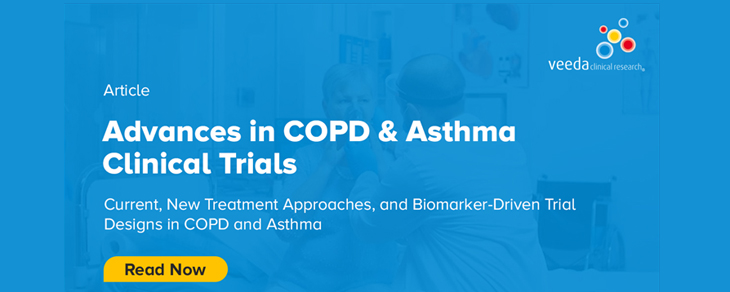Quantifying Pharmacodynamic Biomarkers: Drug Impact and Bioanalysis in New Chemical Entity Development
January 11, 2024
Home > Veeda Insights > Advancements in COPD & Asthma Treatments: Challenges and Future Directions

Chronic Obstructive Pulmonary Disease (COPD) and Asthma are significant respiratory conditions that affect millions worldwide. In 2019, COPD accounted for 3.3 million deaths and 74.4 million disability-adjusted life years (DALYs), with a global prevalence of 212.3 million cases. Meanwhile, the prevalence of Asthma has been rising due to increased life expectancy and changing demographics. Additionally, the overlap of Asthma and COPD cases has become more frequent, presenting unique challenges in diagnosis and treatment.
Researchers face challenges in developing novel drugs for Asthma and COPD, including limited investment by pharmaceutical companies, lack of funding for basic research, and a scarcity of helpful biomarkers. To overcome these hurdles, identifying new therapeutic targets and biomarkers is crucial for better patient selection and long-term therapy monitoring.
Biomarker-driven trial designs are transforming the landscape of COPD and Asthma treatments, offering a more precise and personalized approach to patient care. These innovative trial designs focus on specific biomarkers that play a crucial role in understanding the underlying mechanisms of these respiratory conditions and predicting treatment responses.
In COPD, eosinophilic inflammation is a key biomarker that helps identify patients who are more likely to respond favorably to inhaled corticosteroids (ICS) and certain biologic therapies targeting type 2 inflammation. Conversely, in non-type 2 inflammation, neutrophilia becomes a significant biomarker, guiding clinicians to explore alternative treatment strategies due to a reduced response to ICS.
For Asthma, fractional exhaled nitric oxide (FeNO) levels serve as a valuable biomarker for type 2 inflammation. Elevated FeNO levels are associated with a higher likelihood of responding well to ICS and specific biologic agents like anti-IgE and anti-IL-4R treatments. Additionally, IgE levels can indicate atopy and predict better responses to ICS and anti-IgE treatments.
Periostin emerges as a promising biomarker in both COPD and Asthma. It is associated with type 2 inflammation and airway remodeling, making it a potential indicator of treatment response to anti-IL-13 therapies in Asthmatic individuals with high periostin levels.
Biomarkers are essential tools in guiding treatment decisions and assessing therapy response for Asthma and COPD. These biomarkers help in patient stratification, identifying subgroups likely to respond to specific therapies, and reducing the risk of adverse effects.
Contract Research Organizations (CROs) play a crucial role in advancing biomarker-driven research. They possess specialized expertise in biomarker discovery, validation, and analysis, accelerating the translation of research findings into clinical applications
In conclusion, COPD and Asthma present significant global health challenges, affecting millions of people and causing substantial morbidity and mortality. The current treatment landscape has seen advancements, but unmet needs persist. Biomarkers offer promising opportunities fo personalized treatments, while CROs play a crucial role in advancing research and developmen efforts. To address the challenges, increased investment in respiratory medicine research is essential. By fostering collaboration and innovation among stakeholders, we can strive toward better management and improved outcomes for patients living with COPD and Asthma ultimately enhancing their quality of life.
